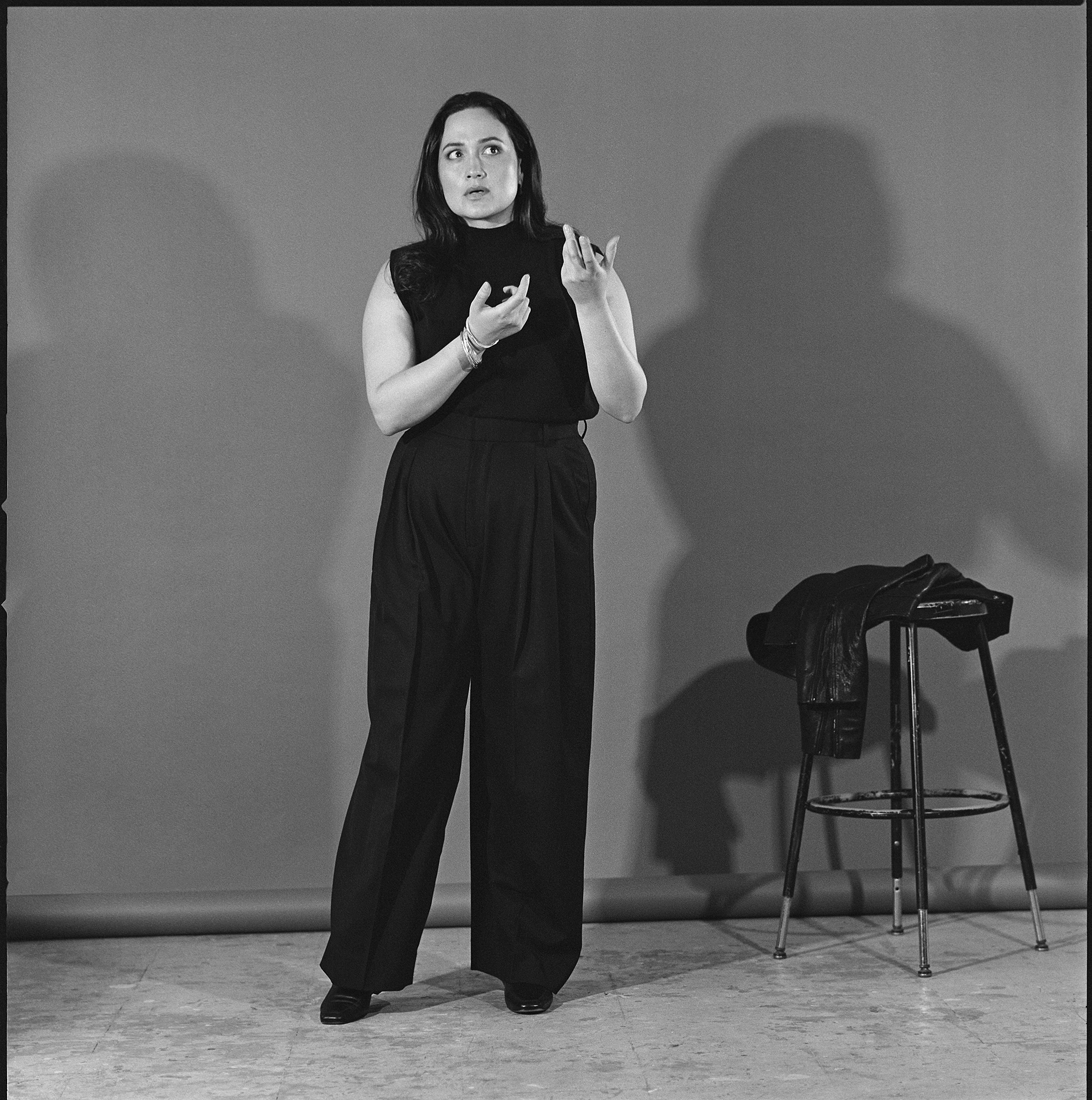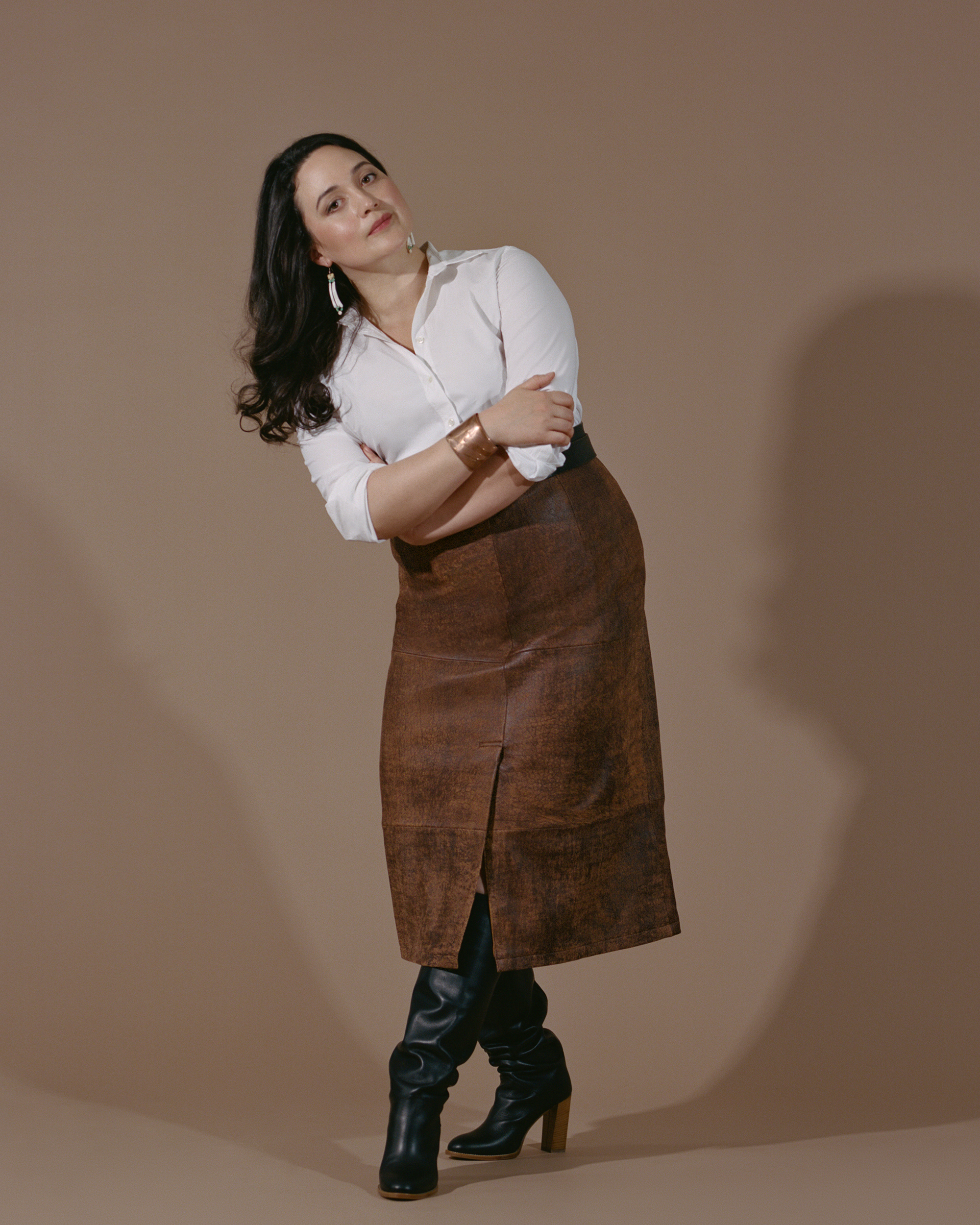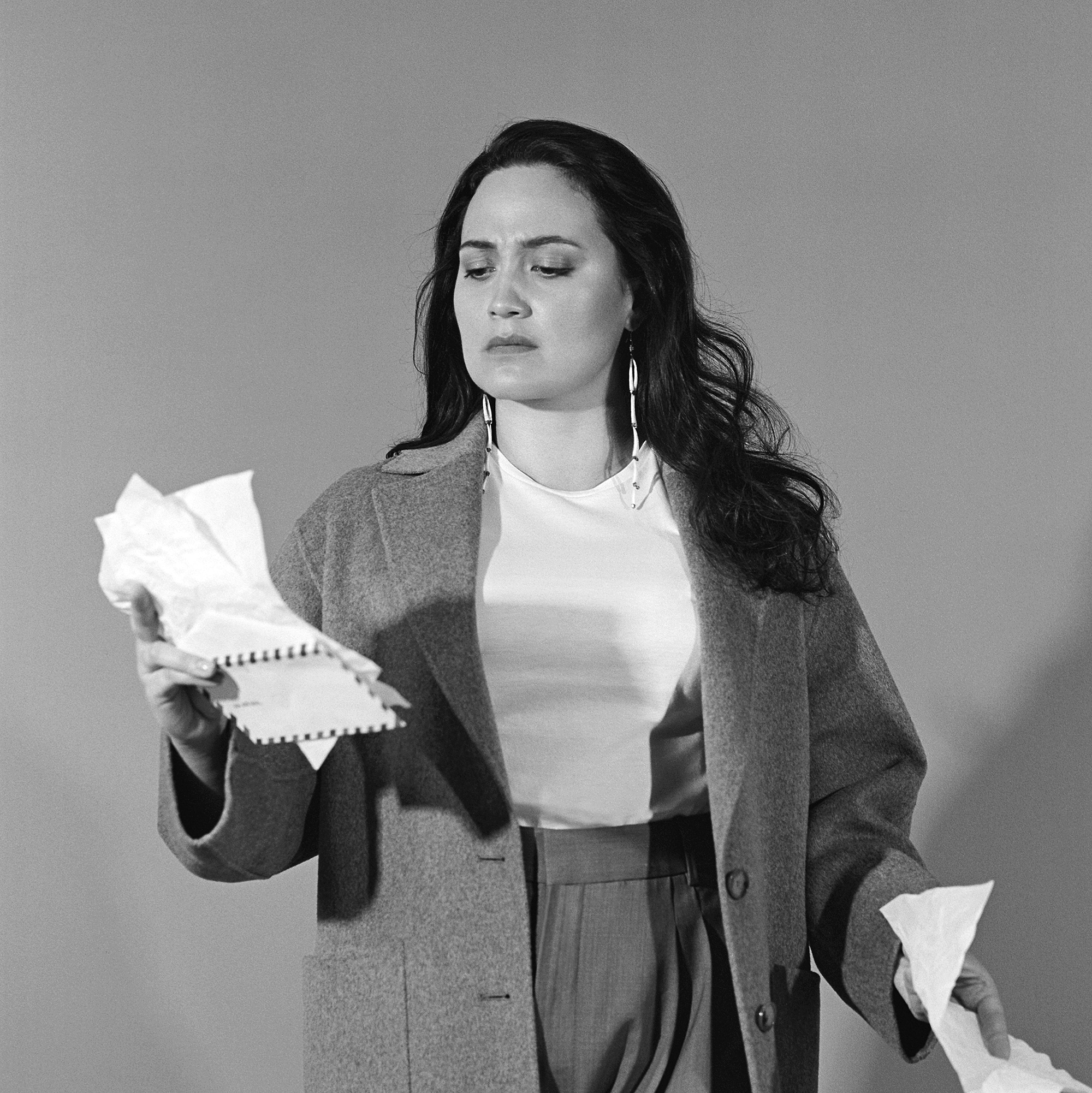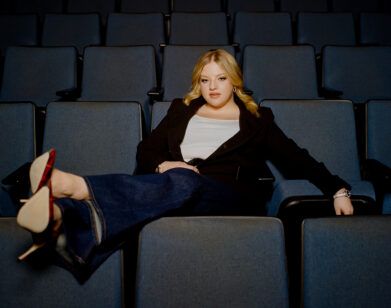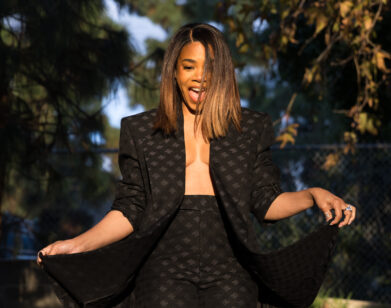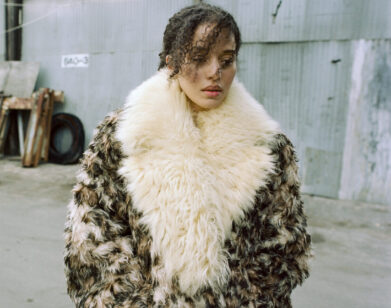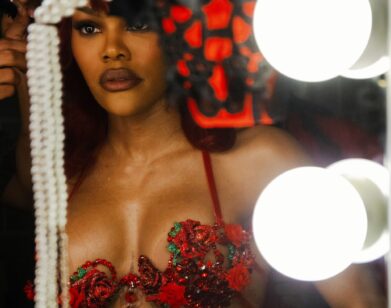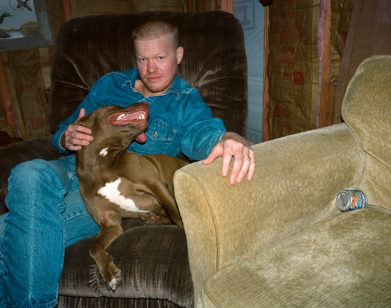ARRIVAL
Lily Gladstone Talks Killers of the Flower Moon With Kelly Reichardrt
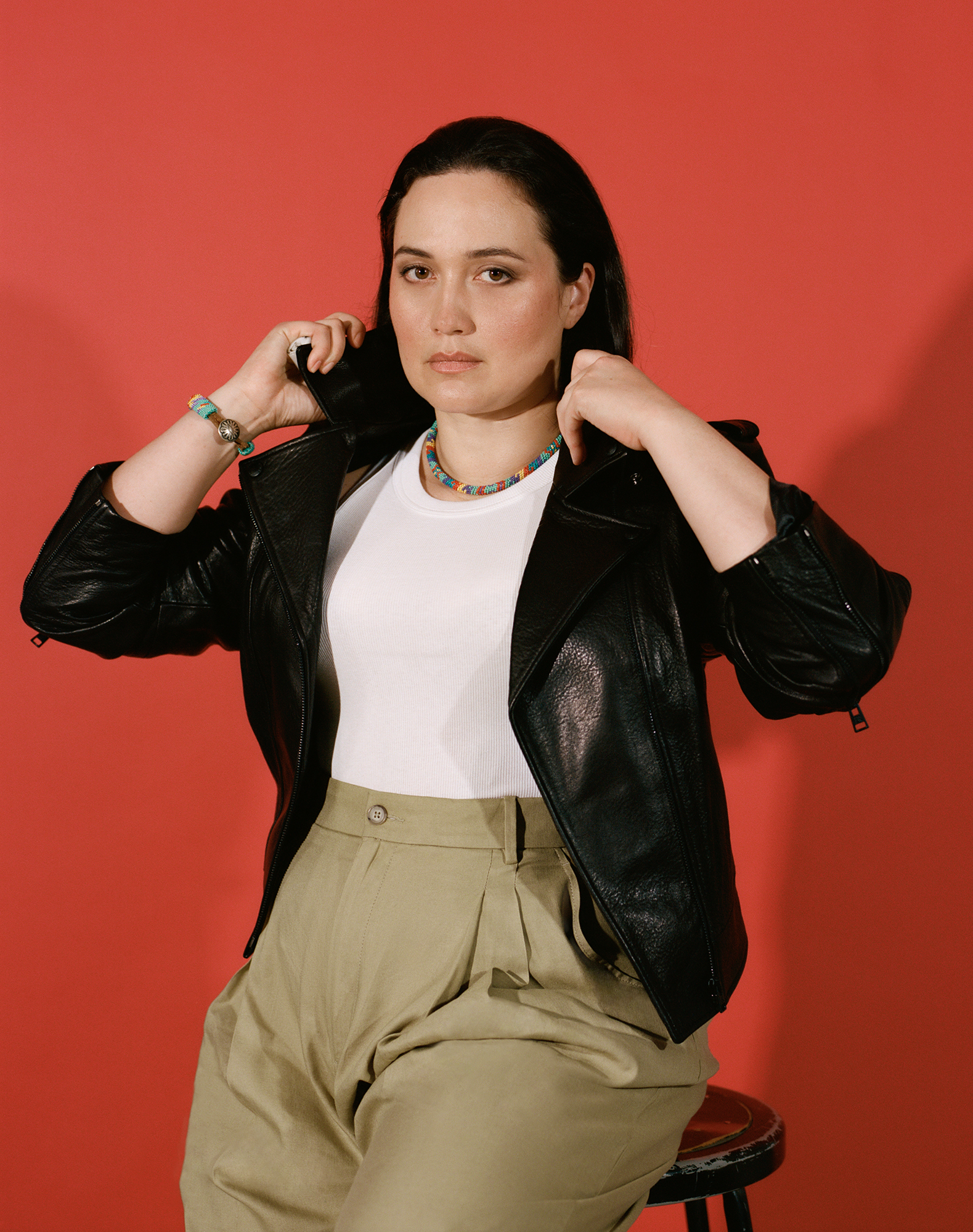
Lily Gladstone wears Jacket, Tank Top, and Lena Pant Banana Republic. Jewelry (worn throughout) Lily’s own.
For Lily Gladstone, Killers of the Flower Moon, a greed-fueled crime saga surrounding the real-life systematic murder of oil-rich Osage people in 1920s Oklahoma, was more than just a chance be directed by Martin Scorsese or act alongside Leonardo DiCaprio. The three-hour epic gave the 37-year-old actor, who grew up on the Blackfeet Reservation in Montana, a chance to tap into her own trauma and resiliency. That process was on the top of Gladstone’s mind when she connected with her Certain Women director Kelly Reichardt, who could barely contain her pride.
———
LILY GLADSTONE: Kelly!
KELLY REICHARDT: Lily!
GLADSTONE: Here I am. [Laughs]
REICHARDT: How are you, hon? Are you in total press mode?
GLADSTONE: Kind of. We’re doing as much as we can before we figure out what SAG’s doing this week. Ninety-eight percent of the people who voted, voted to strike if we need to.
REICHARDT: Oh, okay. So are we picketing right now?
GLADSTONE: No, not yet. You and me are good.
REICHARDT: Okay. Where are you?
GLADSTONE: I’m in Tulsa. We premiered the film for Osage Nation on Saturday.
REICHARDT: Oh, wow. I just saw that judge shut down the reparations lawsuit [for the Tulsa Race Massacre].
GLADSTONE: Everything that these Oklahomans are doing is—to say that the objection to teaching about the Tulsa massacre at Greenwood wasn’t race-driven is just—every teacher in the state’s too afraid to teach Killers of the Flower Moon.
REICHARDT: Well, I got to watch the film. You’re so commanding and comfortable. It’s really a beautiful performance, Lily.
GLADSTONE: Thank you, Kelly.
REICHARDT: So, I hate to ask, but I remember that your grandmother helped you with the Chinook Wawa. And I was wondering, was she involved in—what is the language
you’re speaking, Lily?
GLADSTONE: Osage. It’s the Francocized version of Wažáže. It was written down in French as “Osage” so that’s how it’s read in English. But my grandma, we’ve lost her in the last year.
REICHARDT: I’m sorry. Did she know you were in this film?
GLADSTONE: She did. She had dementia so it was nice to surprise her with the news, over, and over, and over again. It was the first time in my whole acting journey that she’s heard of anybody that I was working with. [Laughs]
REICHARDT: Right.
GLADSTONE: I said, “Yeah, grandma, I’m doing a Martin Scorsese film.” “Ooh, Martin Scorsese.” “Robert DeNiro’s in it.” “Ooh, DeNiro.” And then I said, “Leonardo DiCaprio.” And she screwed her face up. She’s like, “Who’s that?”
REICHARDT: [Laughs]
GLADSTONE: And then, I showed her a copy of Titanic, and she was really excited. [Laughs]
REICHARDT: How did the movie come to you?
GLADSTONE: I think Marty watched Certain Women, Kelly. [Laughs]
REICHARDT: Well, it’s impressive that he keeps up with so many movies.
GLADSTONE: He’s encyclopedic. He’s the entire culture of film history walking around in one body.
REICHARDT: Did you read for him, or were you just called in?
GLADSTONE: Initially, it was a selftape. I had a couple of different people help me.
REICHARDT: How much did they give you to work with?
GLADSTONE: Before the rewrites, I had three pages of some pretty mouthy dialogue. But I was struggling so much with the scenes that, when COVID shut everything down and the project went quiet for a minute, I assumed that I’d blown the audition. About a year later, I got a request to Zoom with Martin Scorsese.
REICHARDT: Oh, wow.
GLADSTONE: And then I got new sides sent to me that had beats. Suddenly it was a scene that had minimal dialogue—it was that dinner scene, the first date where Mollie [Gladstone’s character] is feeling out Ernest [Leonardo DiCaprio’s character and her husband in the film]. And I was like, “Oh man, I can plug a character in here now. This is amazing.” Because I’d heard that the rewrites completely did a 180. Leo was supposed to be playing Tom White, Jesse Plemons’s character.
REICHARDT: Yeah.
GLADSTONE: And so, the focus would’ve been the FBI, with Mollie and Ernest being part of the supporting storyline, instead of the central one.
REICHARDT: Yeah.
GLADSTONE: So that first meeting with Marty was on my dad’s birthday. And then, a week later, Marty set up a meeting with me and him and Leo over Zoom. That was a two-and-a-half-hour conversation. I had my sides next to me and was expecting that we would do some scene work, but it was just a preliminary discussion about the project. Then, when I got a call on December 1st from my manager, it was the offer.
REICHARDT: Because by the time you start reading, you’re already having to learn the language.
GLADSTONE: The day that I got cast is when I went to the Osage language app and taught myself the orthography as best as I could. It’s funny, I didn’t know my grandma spoke Nez Perce [the namesake language of an Indigenous tribe from the Northwest Plateau]. My grandpa being Blackfeet, and then growing up on the Blackfeet Reservation, that was the language I was used to being around and hearing. I can introduce myself, I’ve got a few words and phrases. But Chinook was a completely different set of phonetics.
REICHARDT: Interesting. With Chinook, I was like, “Well, there’s not that many people to judge you if you’re getting it wrong, because so few people are still speaking it.”
GLADSTONE: Right. I mean, Osage has a really comprehensive language department and there are a number of fluent speakers left. I wanted to do my homework before I started working with speakers. And I had about two months to learn and work on the orthography myself, which is incredible. I can still read it.
REICHARDT: And then you’re on the ground in Oklahoma. How much did they build where you were shooting?
GLADSTONE: Downtown Pawhuska was built during the ’20s. Right now, some of the buildings are occupied, and some of them are abandoned, but they were rented out from the owners. Then, the faces of them were dressed up to look like the time. Some didn’t need any changing.
REICHARDT: So you guys took over the town.
GLADSTONE: Yeah. They put red dirt over the pavement to make it look like the ’20s. If you go to Pawhuska now, some of the buildings still have the signs that were painted on them.
REICHARDT: Wait—because it was COVID, were you meeting the other actors when you got there? You hadn’t met DeNiro before, right?
GLADSTONE: I hadn’t, no. But Leo and I had dinner beforehand and got a chance to talk. The two of us took meetings with community members. He and I met Margie Burkhart, our characters’ granddaughter. Whenever I come to Oklahoma, I set aside a week or two to hang out and visit people. I made some pretty significant relationships while making this film.
REICHARDT: How long did you guys shoot for? I probably don’t want to know, right?
GLADSTONE: Six months. But the first six weeks I was there doing in-person community building, which was so necessary for any of this to have been done right.
REICHARDT: And when you shoot for six months, is that five-day weeks? What kind of hours is it?
GLADSTONE: There’s a significant chunk of the film there where Mollie is not well. So we’re not seeing her as often.
REICHARDT: Yeah, it seems she’s doing a lot of acting from bed.
GLADSTONE: Yeah. The wasting illness. I had a couple-week hold for the very restrictive diet and exercise plan that I was on to get there. [Laughs] I accomplished an almost 30-pound weight loss during that time.
REICHARDT: That’s what happens when you have all those blankets on you.
GLADSTONE: [Laughs] We came to find out.
REICHARDT: And when Mr. Scorsese comes to set, does he ever get stressed?
GLADSTONE: Oh, sure. We all do. He’s got such a buoyant sense of humor, though. When Marty’s stressed, it’s like, “Okay. I got you.” That’s the best that you can do.
REICHARDT: [Laughs] So six months and then everyone goes their own way. Did you have the fall after the project was done?
GLADSTONE: I knew that the big empty space ahead of me was going to be the time that I could just enjoy my life as I know it now.
REICHARDT: Yeah.
GLADSTONE: The first big acclimation that I had was after Certain Women. I knew that your film would be getting a lot of attention, but I didn’t anticipate that I would be getting as much attention as I did. That prepared me for the flashes in my face, and the people trying to get something out of you in interviews. It’s like I had a crash course on being in the public eye. It was stressful. But, this time around, I’m like, “It doesn’t last forever.” What survives is the work and the story that you were there to tell.
REICHARDT: And did people stay in their characters somewhat throughout?
GLADSTONE: There were only a few times. Having been cast into this incredibly tricky love story, without Leo and I ever having had a chemistry read before jumping into it—we spent a lot of time just getting to know each other, finding our movements and pace. It was important to him that we have this language of a couple that had been together.
REICHARDT: Right.
GLADSTONE: I found doing this piece, with the heavy trauma of it— it’s the same way a lot of people in my community back home talk about our history. Blackfeet have our own versions of the traumatic history that we collectively still feel. And it’s just an ethos in my people that if you’re dealing with trauma, it needs a counterbalance. And I needed that in my performances. If I tried to stay in the trauma of it, I would exhaust myself. The other Native actors were also getting compliments from people about our ability to come out of it. In the scene where me and JaNae [Collins]—who by the way is my actual cousin.
REICHARDT: Wait, what?
GLADSTONE: Yeah. The actress who plays Rita Smith, she and I are cousins through her mom. But anyways, the scene where our mother is passing away, we’re sobbing over our mother leaving this earth, and then as soon as they call cut, we just start cracking up. It was remarkably light and fun, given what the content was. It felt like we had that responsibility working with the Osage community. It’s their world we’re coming into and I feel a responsibility for people to have a good time and have good memories of being on set.
REICHARDT: Was it not until the court case that Mollie has her suspicions? Or are they there all along?
GLADSTONE: Me and the sisters decided how we felt about [William] Hale [Robert De Niro’s character] together, because we’re familiar with people in our communities who are a friend of the Indian, and collect all the arts, and claim all the relationships, and learn how to speak our language better than we do. That type is very familiar, especially for those of us who grew up on our reservations.
REICHARDT: Right.
GLADSTONE: My dad told me to research Natawista [Iksina], “Medicine Snake Woman,” who was married to a trapper diplomat named Alexander Culbertson. He wasn’t a Hale in the sense that he was murdering people, but he was a very capitalistic man with this Indian woman who helped him grease the wheels of trade. She was my great, great, great-grandfather Red Crow’s aunt; that’s how JaNae and I are related. We’re both from Montana reservations. I mean, Gladstone was a lumber-baron name that married into Indian Country back a number of generations. So JaNae and I both have, in our shared family history, these white men who love Indian women and Indian people, but are doing the work of colonization. So, even though it might not be explicit in the film, JaNae and I both decided that we viewed Hale that way.
REICHARDT: Mm-hmm.
GLADSTONE: Our communities are generous and accepting of people, but you know what people’s nature is. So, when things start going down, that’s where suspicion arises. And, when you love somebody, and you see the little hurt boy in them, you become codependent and start mothering them a bit.
REICHARDT: And he is physically caring for you so it’s really complicated. But your performance is so subtle. You see that you’re getting sicker and more vulnerable. And because it’s often filmed from us looking at Mollie, it’s like we’re watching from the point of view of Leo’s character; we’re Ernest.
GLADSTONE: Exactly. I didn’t want to make her doe-eyed in love. It’s a complicated thing when you love somebody, especially when you have an awareness that they’ve tremendously fucked up. The descendants of Mollie had put together that her insulin was likely laced with morphine to hook her to it. And then, arsenic was introduced. So it was this cocktail of getting better and getting worse. I placed a lot of the love she had for Ernest behind this veil of morphine addiction.
REICHARDT: Wow.
GLADSTONE: I know this from the history—it’s not in the film, but Mollie did not die incompetent. She worked very hard until the end of her life and was eventually in charge of her own finances. She took Ernest to court after the trials. She got a lot of money back from him that he had embezzled or mismanaged when he was her guardian. There are some transcriptions of Mollie’s testimony during those later court periods talking about Ernest. She’s like, “I trust him. Yes, I love him.” In the end, she just settled on, “I don’t want harm to befall my husband. But I want the truth to come out for what it is.” And, that’s how I decided I needed to carry Mollie through the end.
REICHARDT: Wow.
GLADSTONE: She doesn’t have the full picture, but she knows that he’s at least complicit.
REICHARDT: Yeah. And she remarried, right?
GLADSTONE: Yeah. But she didn’t live a really long life after that trial. She passed away in 1937. The trial was in 1926, I believe.
REICHARDT: Oh, that is a short time.
GLADSTONE: Mm-hmm. She passed away at age 50 from diabetes. And of course, her body had been incredibly weakened by the period of time that she was getting medicine from the Shoun brothers. But she accomplished a lot in those last 10, 11, 12 years.
REICHARDT: Wowie. I’m not going to say I’m so proud of you, because I had nothing to do with it. But—
GLADSTONE: Oh, bullshit.
REICHARDT: I mean, it was just beautiful to watch you at Cannes. There’s a whole bunch of love coming at you from the folks here in Portland.
GLADSTONE: Thank you, Kelly. I understand the hesitance to say you’re proud of somebody, but it means a lot that you feel that. And of course, you had so much to do with this. There are not many people who can create a character that gives an actor like me a chance to show what I can do. And that was what Marty needed.
REICHARDT: Well I’m sending you a lot of love. Keep us posted on everything.
GLADSTONE: Absolutely.
REICHARDT: And, a big hug to you.
GLADSTONE: Likewise.
This interview and photoshoot was completed before the SAG-Aftra strike.
———
Hair: Jameson Eaton.
Makeup: Cassandra Garcia using Bobbi Brown Cosmetics at The Wall Group.
Nails: Ami Vega using Chanel at Muse NYC.
Photography Assistants: Donna Viering and Gus Aronson.
Fashion Assistant: Fern Cerezo.
Tailor: Shirlee Idzakovich.
Production Assistant: Jordan Santisteban.
Retoucher: Nikita Shaletin.

